

Compact Muon Solenoid
LHC, CERN
| CMS-TOP-18-003 ; CERN-EP-2019-163 | ||
| Search for production of four top quarks in final states with same-sign or multiple leptons in proton-proton collisions at $\sqrt{s}= $ 13 TeV | ||
| CMS Collaboration | ||
| 18 August 2019 | ||
| Eur. Phys. J. C 80 (2020) 75 | ||
| Abstract: The standard model (SM) production of four top quarks (${\mathrm{t\bar{t}}\mathrm{t\bar{t}}} $) in proton-proton collision is studied by the CMS Collaboration. The data sample, collected during the 2016-2018 data taking of the LHC, corresponds to an integrated luminosity of 137 fb$^{-1}$ at a center-of-mass energy of 13 TeV. The events are required to contain two same-sign charged leptons (electrons or muons) or at least three leptons, and jets. The observed and expected significances for the ${\mathrm{t\bar{t}}\mathrm{t\bar{t}}} $ signal are respectively 2.6 and 2.7 standard deviations, and the ${\mathrm{t\bar{t}}\mathrm{t\bar{t}}} $ cross section is measured to be 12.6$^{+5.8}_{-5.2}$ fb. The results are used to constrain the Yukawa coupling of the top quark to the Higgs boson, $y_{\mathrm{t}}$, yielding a limit of $| {y_{\mathrm{t}}/y_{\mathrm{t}}^{\mathrm{SM}}} | < $ 1.7 at 95% confidence level, where $y_{\mathrm{t}}^{\mathrm{SM}}$ is the SM value of $y_{\mathrm{t}}$. They are also used to constrain the oblique parameter of the Higgs boson in an effective field theory framework, $\hat{H}$ < 0.12. Limits are set on the production of a heavy scalar or pseudoscalar boson in Type-II two-Higgs-doublet and simplified dark matter models, with exclusion limits reaching 350-470 GeV and 350-550 GeV for scalar and pseudoscalar bosons, respectively. Upper bounds are also set on couplings of the top quark to new light particles. | ||
| Links: e-print arXiv:1908.06463 [hep-ex] (PDF) ; CDS record ; inSPIRE record ; CADI line (restricted) ; | ||
| Figures | |

png pdf |
Figure 1:
Typical Feynman diagrams for ${{\mathrm{t} \mathrm{\bar{t}}} {\mathrm{t} \mathrm{\bar{t}}}}$ production at leading order in the SM. |
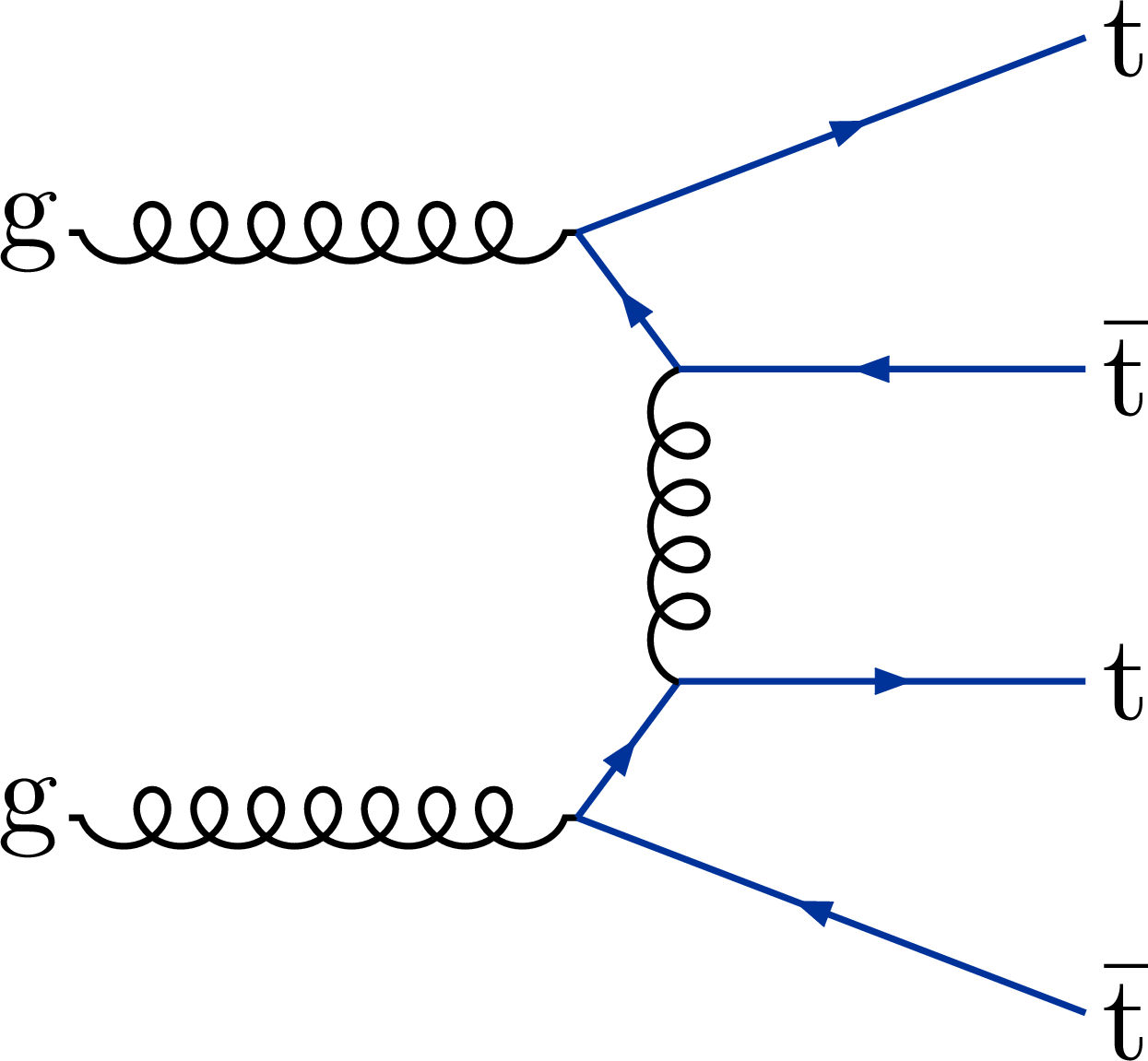
png pdf |
Figure 1-a:
Typical Feynman diagram for ${{\mathrm{t} \mathrm{\bar{t}}} {\mathrm{t} \mathrm{\bar{t}}}}$ production at leading order in the SM. |
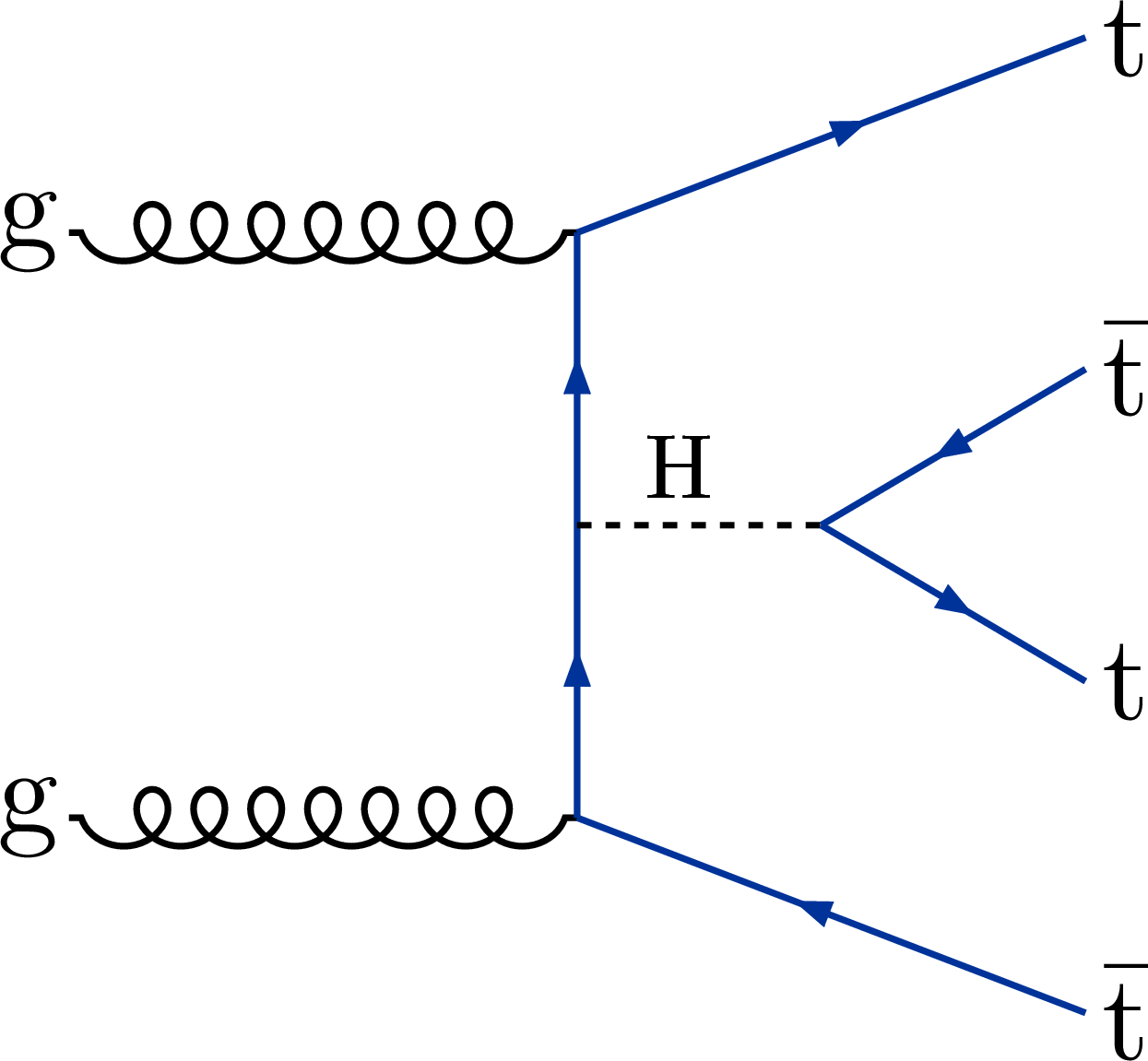
png pdf |
Figure 1-b:
Typical Feynman diagram for ${{\mathrm{t} \mathrm{\bar{t}}} {\mathrm{t} \mathrm{\bar{t}}}}$ production at leading order in the SM. |

png pdf |
Figure 2:
Distributions of ${N_\text {jets}}$ (upper left), ${N_\mathrm{b}}$ (upper right), ${H_{\mathrm {T}}}$ (lower left), and ${{p_{\mathrm {T}}} ^\text {miss}}$ (lower right) in the summed SRs (1-14), before fitting to data, where the last bins include the overflows. The hatched areas represent the total uncertainties in the SM signal and background predictions. The ${{\mathrm{t} \mathrm{\bar{t}}} {\mathrm{t} \mathrm{\bar{t}}}}$ signal assumes the SM cross section from Ref. [1]. The lower panels show the ratios of the observed event yield to the total prediction of signal plus background. |
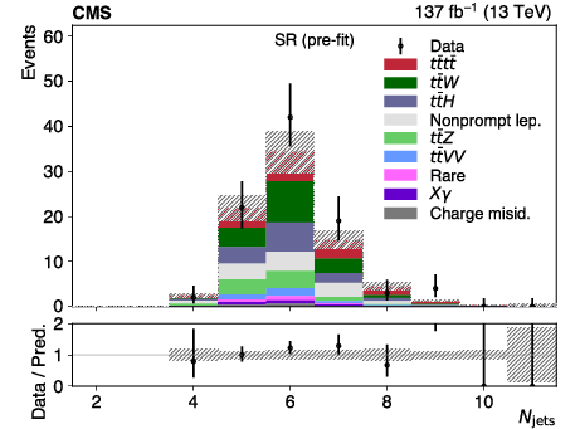
png pdf |
Figure 2-a:
Distribution of ${N_\text {jets}}$ in the summed SRs (1-14), before fitting to data, where the last bin includes the overflows. The hatched areas represent the total uncertainties in the SM signal and background predictions. The ${{\mathrm{t} \mathrm{\bar{t}}} {\mathrm{t} \mathrm{\bar{t}}}}$ signal assumes the SM cross section from Ref. [1]. The lower panel shows the ratios of the observed event yield to the total prediction of signal plus background. |

png pdf |
Figure 2-b:
Distribution of ${N_\mathrm{b}}$ in the summed SRs (1-14), before fitting to data, where the last bin includes the overflows. The hatched areas represent the total uncertainties in the SM signal and background predictions. The ${{\mathrm{t} \mathrm{\bar{t}}} {\mathrm{t} \mathrm{\bar{t}}}}$ signal assumes the SM cross section from Ref. [1]. The lower panel shows the ratios of the observed event yield to the total prediction of signal plus background. |
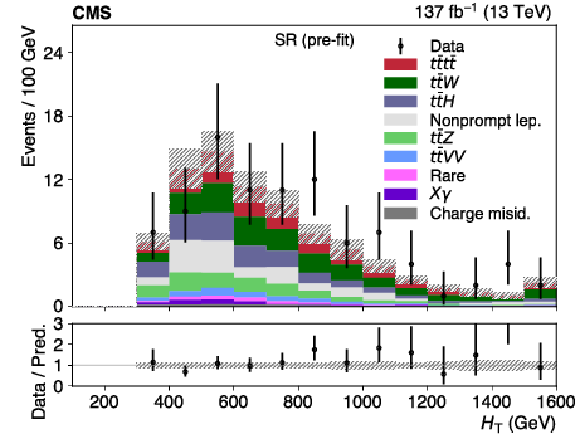
png pdf |
Figure 2-c:
Distribution of ${H_{\mathrm {T}}}$ in the summed SRs (1-14), before fitting to data, where the last bin includes the overflows. The hatched areas represent the total uncertainties in the SM signal and background predictions. The ${{\mathrm{t} \mathrm{\bar{t}}} {\mathrm{t} \mathrm{\bar{t}}}}$ signal assumes the SM cross section from Ref. [1]. The lower panel shows the ratios of the observed event yield to the total prediction of signal plus background. |
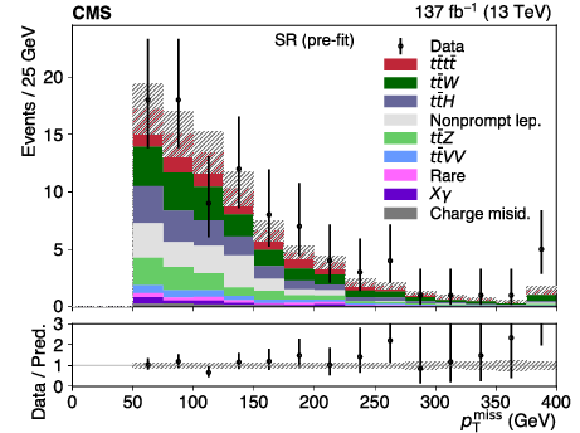
png pdf |
Figure 2-d:
Distribution of ${{p_{\mathrm {T}}} ^\text {miss}}$ in the summed SRs (1-14), before fitting to data, where the last bin includes the overflows. The hatched areas represent the total uncertainties in the SM signal and background predictions. The ${{\mathrm{t} \mathrm{\bar{t}}} {\mathrm{t} \mathrm{\bar{t}}}}$ signal assumes the SM cross section from Ref. [1]. The lower panel shows the ratios of the observed event yield to the total prediction of signal plus background. |
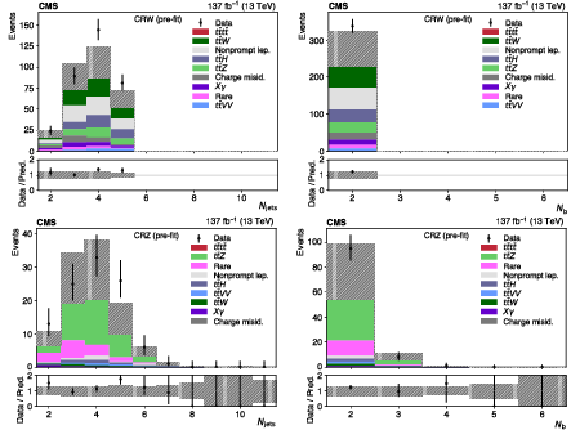
png pdf |
Figure 3:
Distributions of ${N_\text {jets}}$ (left) and ${N_\mathrm{b}}$ (right) in the ${{\mathrm{t} \mathrm{\bar{t}}} \mathrm{W}}$ (upper) and ${{\mathrm{t} \mathrm{\bar{t}}} \mathrm{Z}}$ (lower) CRs, before fitting to data. The hatched areas represent the uncertainties in the SM signal and background predictions. The ${{\mathrm{t} \mathrm{\bar{t}}} {\mathrm{t} \mathrm{\bar{t}}}}$ signal assumes the SM cross section from Ref. [1]. The lower panels show the ratios of the observed event yield to the total prediction of signal plus background. |

png pdf |
Figure 3-a:
Distribution of ${N_\text {jets}}$ in the ${{\mathrm{t} \mathrm{\bar{t}}} \mathrm{W}}$ CR, before fitting to data. The hatched areas represent the uncertainties in the SM signal and background predictions. The ${{\mathrm{t} \mathrm{\bar{t}}} {\mathrm{t} \mathrm{\bar{t}}}}$ signal assumes the SM cross section from Ref. [1]. The lower panel shows the ratios of the observed event yield to the total prediction of signal plus background. |

png pdf |
Figure 3-b:
Distribution of ${N_\mathrm{b}}$ in the ${{\mathrm{t} \mathrm{\bar{t}}} \mathrm{W}}$ CR, before fitting to data. The hatched areas represent the uncertainties in the SM signal and background predictions. The ${{\mathrm{t} \mathrm{\bar{t}}} {\mathrm{t} \mathrm{\bar{t}}}}$ signal assumes the SM cross section from Ref. [1]. The lower panel shows the ratios of the observed event yield to the total prediction of signal plus background. |
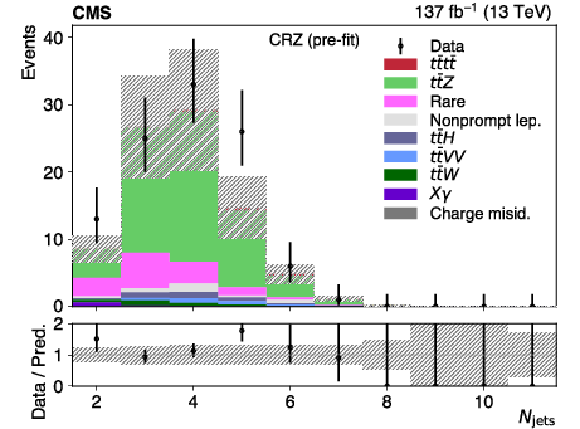
png pdf |
Figure 3-c:
Distribution of ${N_\text {jets}}$ in the ${{\mathrm{t} \mathrm{\bar{t}}} \mathrm{Z}}$ CR, before fitting to data. The hatched areas represent the uncertainties in the SM signal and background predictions. The ${{\mathrm{t} \mathrm{\bar{t}}} {\mathrm{t} \mathrm{\bar{t}}}}$ signal assumes the SM cross section from Ref. [1]. The lower panel shows the ratios of the observed event yield to the total prediction of signal plus background. |
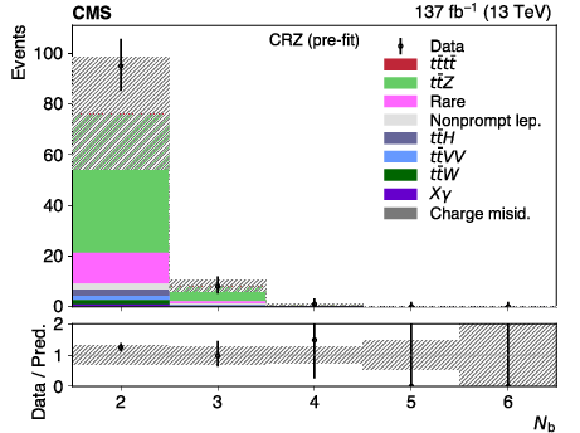
png pdf |
Figure 3-d:
Distribution of ${N_\mathrm{b}}$ in the ${{\mathrm{t} \mathrm{\bar{t}}} \mathrm{Z}}$ CR, before fitting to data. The hatched areas represent the uncertainties in the SM signal and background predictions. The ${{\mathrm{t} \mathrm{\bar{t}}} {\mathrm{t} \mathrm{\bar{t}}}}$ signal assumes the SM cross section from Ref. [1]. The lower panel shows the ratios of the observed event yield to the total prediction of signal plus background. |
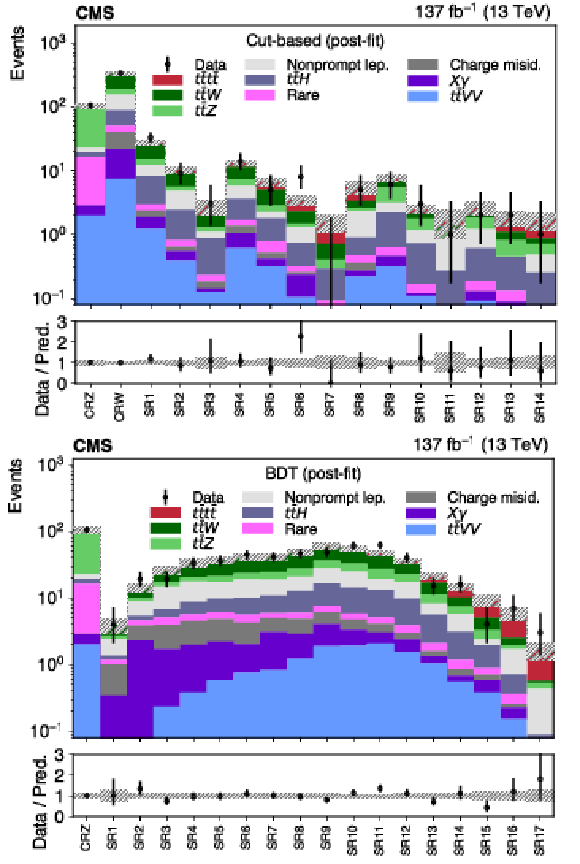
png pdf |
Figure 4:
Observed yields in the control and signal regions for the cut-based (upper) and BDT (lower) analyses, compared to the post-fit predictions for signal and background processes. The hatched areas represent the total post-fit uncertainties in the signal and background predictions. The lower panels show the ratios of the observed event yield to the total prediction of signal plus background. |

png pdf |
Figure 4-a:
Observed yields in the control and signal regions for the cut-based analysis, compared to the post-fit predictions for signal and background processes. The hatched areas represent the total post-fit uncertainties in the signal and background predictions. The lower panel shows the ratios of the observed event yield to the total prediction of signal plus background. |

png pdf |
Figure 4-b:
Observed yields in the control and signal regions for the BDT analysis, compared to the post-fit predictions for signal and background processes. The hatched areas represent the total post-fit uncertainties in the signal and background predictions. The lower panel shows the ratios of the observed event yield to the total prediction of signal plus background. |
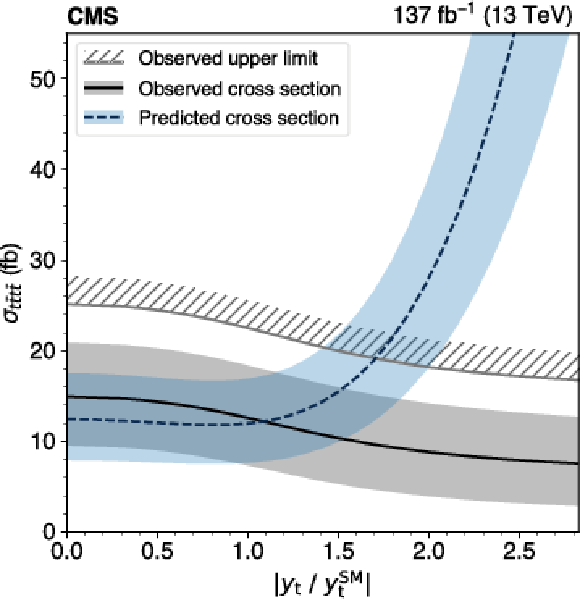
png pdf |
Figure 5:
The observed ${\sigma ({\mathrm{p}} {\mathrm{p}} \to {{\mathrm{t} \mathrm{\bar{t}}} {\mathrm{t} \mathrm{\bar{t}}}}})$ (solid line) and 95% CL upper limit (hatched line) are shown as a function of $ {| y_{\mathrm{t}}/y_{\mathrm{t}}^{\mathrm {SM}} |}$. The predicted value (dashed line) [2], calculated at LO and scaled to the calculation from Ref. [1], is also plotted. The shaded band around the measured value gives the total uncertainty, while the shaded band around the predicted curve shows the theoretical uncertainty associated with the renormalization and factorization scales. |

png pdf |
Figure 6:
The 95% CL exclusion regions in the plane of the $\phi /\mathrm{Z'} $-top quark coupling versus $m_{\phi}$ or $m_{\mathrm{Z'}}$. The excluded regions are above the hatched lines. |

png pdf |
Figure 7:
The observed (points) and expected (dashed line) 95% CL upper limits on the cross section times branching fraction to ${\mathrm{t} \mathrm{\bar{t}}}$ for the production of a new heavy scalar H (left) and pseudoscalar A (right), as a function of mass. The inner and outer bands around the expected limits indicate the regions containing 68 and 95%, respectively, of the distribution of limits under the background-only hypothesis. Theoretical values are shown for Type-II 2HDM in the alignment limit (solid line) and simplified dark matter (dot-dashed line) models. |
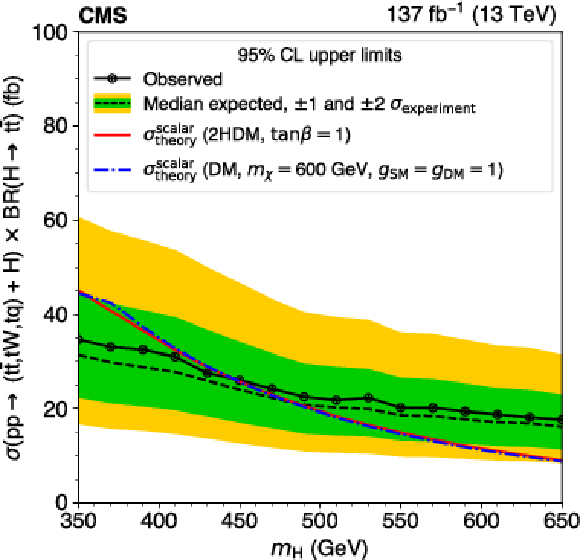
png pdf |
Figure 7-a:
The observed (points) and expected (dashed line) 95% CL upper limits on the cross section times branching fraction to ${\mathrm{t} \mathrm{\bar{t}}}$ for the production of a new heavy scalar H, as a function of mass. The inner and outer bands around the expected limits indicate the regions containing 68 and 95%, respectively, of the distribution of limits under the background-only hypothesis. Theoretical values are shown for Type-II 2HDM in the alignment limit (solid line) and simplified dark matter (dot-dashed line) models. |
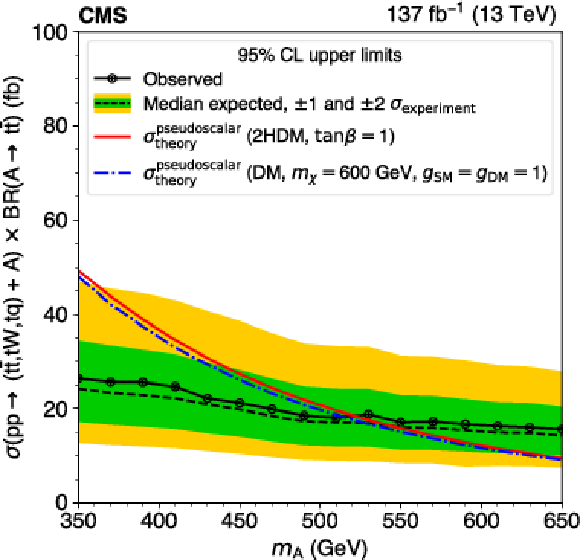
png pdf |
Figure 7-b:
The observed (points) and expected (dashed line) 95% CL upper limits on the cross section times branching fraction to ${\mathrm{t} \mathrm{\bar{t}}}$ for the production of a new heavy pseudoscalar A, as a function of mass. The inner and outer bands around the expected limits indicate the regions containing 68 and 95%, respectively, of the distribution of limits under the background-only hypothesis. Theoretical values are shown for Type-II 2HDM in the alignment limit (solid line) and simplified dark matter (dot-dashed line) models. |
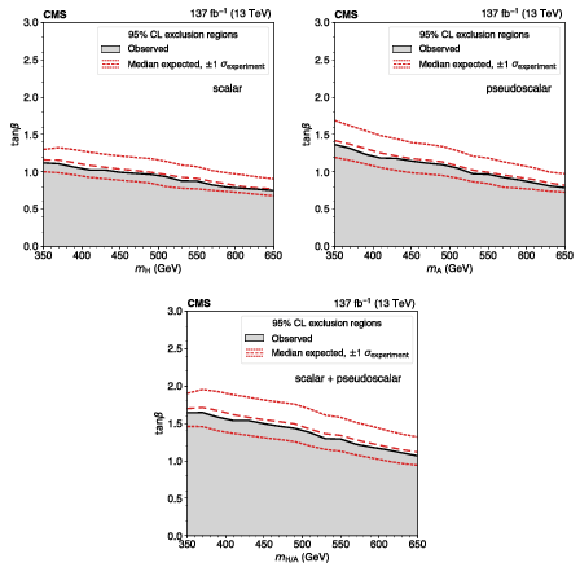
png pdf |
Figure 8:
The observed (solid curve) and expected (long-dashed curve) 95% CL exclusion regions in the $\tan\beta $ versus mass plane for Type-II 2HDM models in the alignment limit for a new scalar H (upper left), pseudoscalar A (upper right), and both (lower) particles. The short-dashed curves around the expected limits indicate the region containing 68% of the distribution of limits expected under the background-only hypothesis. The excluded regions are below the curves. |

png pdf |
Figure 8-a:
The observed (solid curve) and expected (long-dashed curve) 95% CL exclusion regions in the $\tan\beta $ versus mass plane for Type-II 2HDM models in the alignment limit for a new scalar H. The short-dashed curves around the expected limits indicate the region containing 68% of the distribution of limits expected under the background-only hypothesis. The excluded regions are below the curves. |
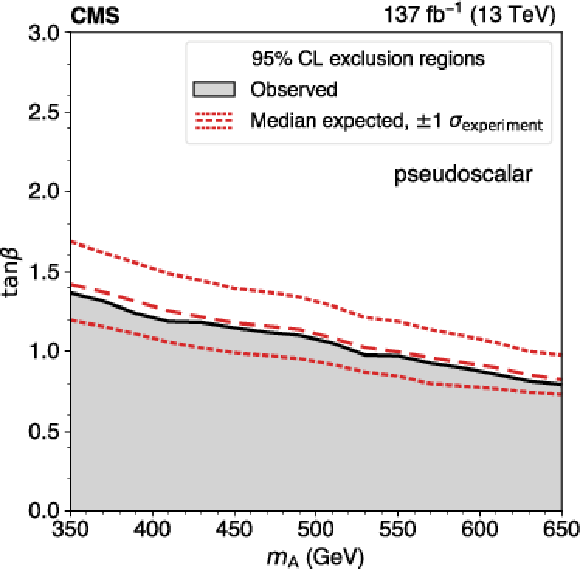
png pdf |
Figure 8-b:
The observed (solid curve) and expected (long-dashed curve) 95% CL exclusion regions in the $\tan\beta $ versus mass plane for Type-II 2HDM models in the alignment limit for a new pseudoscalar A. The short-dashed curves around the expected limits indicate the region containing 68% of the distribution of limits expected under the background-only hypothesis. The excluded regions are below the curves. |
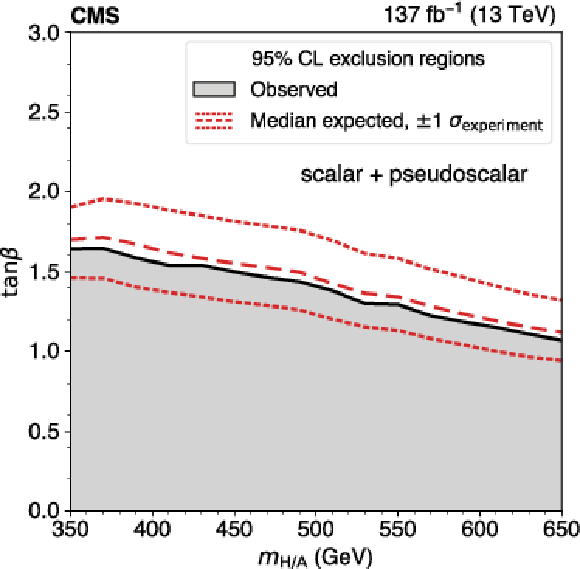
png pdf |
Figure 8-c:
The observed (solid curve) and expected (long-dashed curve) 95% CL exclusion regions in the $\tan\beta $ versus mass plane for Type-II 2HDM models in the alignment limit for both a new scalar H and a new pseudoscalar A. The short-dashed curves around the expected limits indicate the region containing 68% of the distribution of limits expected under the background-only hypothesis. The excluded regions are below the curves. |

png pdf |
Figure 9:
Exclusion regions at 95% CL in the plane of $m_\chi $ vs. $m_{\mathrm{H}}$ (left) or $m_{\mathrm{A} }$ (right). The outer lighter and inner darker solid curves show the expected and observed limits, respectively, assuming $g_\mathrm {SM} = g_\mathrm {DM} = $ 1. The excluded regions, shaded, are above the limit curves. The dashed lines show the limits assuming a weaker coupling between H/A and $\chi $, $g_\mathrm {DM} = $ 0.5. |
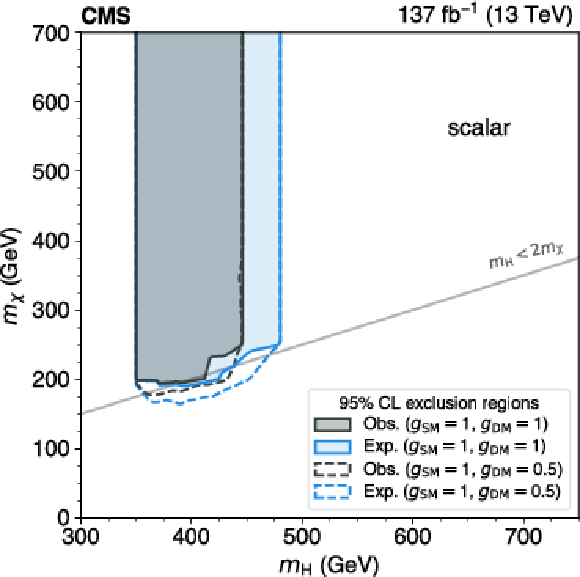
png pdf |
Figure 9-a:
Exclusion regions at 95% CL in the plane of $m_\chi $ vs. $m_{\mathrm{H}}$. The outer lighter and inner darker solid curves show the expected and observed limits, respectively, assuming $g_\mathrm {SM} = g_\mathrm {DM} = $ 1. The excluded regions, shaded, are above the limit curves. The dashed lines show the limits assuming a weaker coupling between H/A and $\chi $, $g_\mathrm {DM} = $ 0.5. |
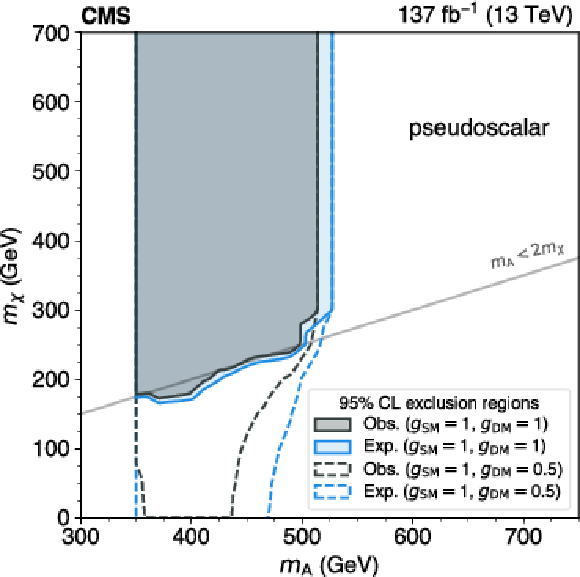
png pdf |
Figure 9-b:
Exclusion regions at 95% CL in the plane of $m_\chi $ vs. $m_{\mathrm{A} }$. The outer lighter and inner darker solid curves show the expected and observed limits, respectively, assuming $g_\mathrm {SM} = g_\mathrm {DM} = $ 1. The excluded regions, shaded, are above the limit curves. The dashed lines show the limits assuming a weaker coupling between H/A and $\chi $, $g_\mathrm {DM} = $ 0.5. |
| Tables | |

png pdf |
Table 1:
Definition of the 14 SRs and two CRs for the cut-based analysis. |

png pdf |
Table 2:
Summary of the sources of uncertainty, their values, and their impact, defined as the relative change of the measurement of $\sigma ({\mathrm{t} \mathrm{\bar{t}}} {\mathrm{t} \mathrm{\bar{t}}})$ induced by one-standard-deviation variations corresponding to each uncertainty source considered separately. The first group lists experimental and theoretical uncertainties in simulated signal and background processes. The second group lists normalization uncertainties in the estimated backgrounds. Uncertainties marked (not marked) with a $\dagger $ in the first column are treated as fully correlated (fully uncorrelated) across the three years of data taking. |
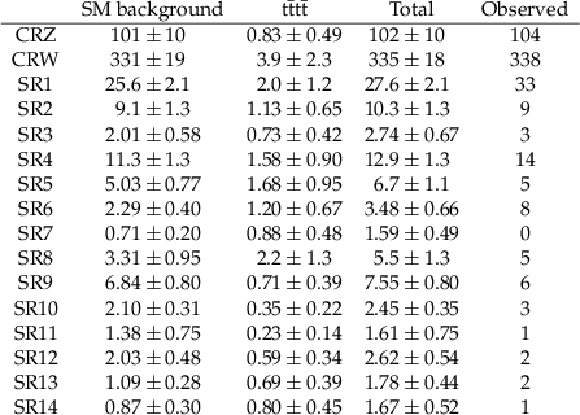
png pdf |
Table 3:
The post-fit predicted background, $ {{\mathrm{t} \mathrm{\bar{t}}} {\mathrm{t} \mathrm{\bar{t}}}} $ signal, and total yields with their total uncertainties and the observed number of events in the control and signal regions in data for the cut-based analysis. |
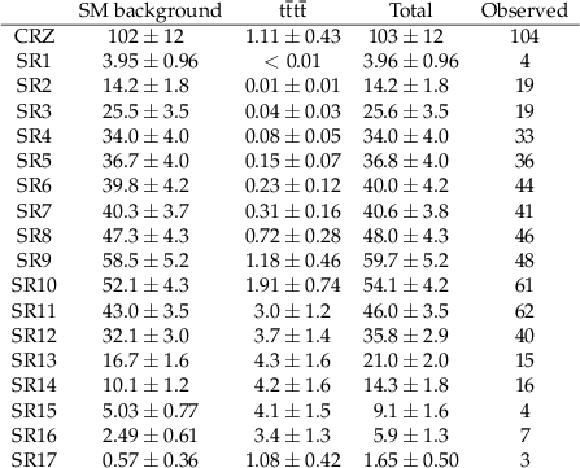
png pdf |
Table 4:
The post-fit predicted background and $ {{\mathrm{t} \mathrm{\bar{t}}} {\mathrm{t} \mathrm{\bar{t}}}} $ signal, and total yields with their total uncertainties and the observed number of events in the control and signal regions in data for the BDT analysis. |
| Summary |
|
The standard model (SM) production of ${\mathrm{t\bar{t}}\mathrm{t\bar{t}}} $ has been studied in data from $\sqrt{s} = $ 13 TeV proton-proton collisions collected using the CMS detector during the LHC 2016-2018 data-taking period, corresponding to an integrated luminosity of 137 fb$^{-1}$. The final state with either two same-sign leptons or at least three leptons is analyzed using two strategies, the first relying on a cut-based categorization in lepton and jet multiplicity and jet flavor, the second taking advantage of a multivariate approach to distinguish the ${\mathrm{t\bar{t}}\mathrm{t\bar{t}}} $ signal from its many backgrounds. The more precise multivariate strategy yields an observed (expected) significance of 2.6 (2.7) standard deviations relative to the background-only hypothesis, and a measured value for the ${\mathrm{t\bar{t}}\mathrm{t\bar{t}}} $ cross section of 12.6$^{+5.8}_{-5.2}$ fb. The results based on the two strategies are in agreement with each other and with the SM prediction of 12.0$^{+2.2}_{-2.5}$ fb [1]. The results of the boosted decision tree (BDT) analysis are also used to constrain the top quark Yukawa coupling $y_{\mathrm{t}}$ relative to its SM value, based on the $| {y_{\mathrm{t}}} |$ dependence of ${\sigma({\mathrm{p}}{\mathrm{p}}\to{\mathrm{t\bar{t}}\mathrm{t\bar{t}}} })$ calculated at leading order in Ref. [2], resulting in the 95% confidence level (CL) limit of $| {y_{\mathrm{t}}/y_{\mathrm{t}}^{\mathrm{SM}}}| < $ 1.7. The Higgs boson oblique parameter in the effective field theory framework [11] is similarly constrained to $\hat{H} < 0.12$ at 95% CL. Upper limits ranging from 0.1 to 1.2 are also set on the coupling between the top quark and a new scalar ($\phi$) or vector (Z') particle with mass less than twice that of the top quark ($m_\mathrm{t}$) [9]. For new scalar (H) or pseudoscalar (A) particles with $m > 2m_\mathrm{t}$, and decaying to $\mathrm{t\bar{t}}$, their production in association with a single top quark or a top quark pair is probed. The resulting cross section upper limit, between 15 and 35 fb at 95% CL, is interpreted in the context of Type-II two-Higgs-doublet models [4,5,6,76] as a function of $\tan \beta$ and $m_{\mathrm{\mathrm{H}/\mathrm{A} }}$, and in the context of simplified dark matter models [7,8], as a function of $m_{\mathrm{\mathrm{H}/\mathrm{A} }}$ and the mass of the dark matter candidate. |
| References | ||||
| 1 | R. Frederix, D. Pagani, and M. Zaro | Large NLO corrections in $ {\rm t\bar{t}W^{\pm}} $ and $ {\rm t\bar{t}t\bar{t}} $ hadroproduction from supposedly subleading EW contributions | JHEP 02 (2018) 031 | 1711.02116 |
| 2 | Q.-H. Cao, S.-L. Chen, and Y. Liu | Probing Higgs width and top quark Yukawa coupling from $ {\rm t\bar{t}H} $ and $ {\rm t\bar{t}t\bar{t}} $ productions | PRD 95 (2017) 053004 | 1602.01934 |
| 3 | Q.-H. Cao et al. | Limiting top-Higgs interaction and Higgs-boson width from multi-top productions | 1901.04567 | |
| 4 | D. Dicus, A. Stange, and S. Willenbrock | Higgs decay to top quarks at hadron colliders | PLB 333 (1994) 126 | hep-ph/9404359 |
| 5 | N. Craig et al. | The hunt for the rest of the Higgs bosons | JHEP 06 (2015) 137 | 1504.04630 |
| 6 | N. Craig et al. | Heavy Higgs bosons at low $ \tan \beta $: from the LHC to 100 TeV | JHEP 01 (2017) 018 | 1605.08744 |
| 7 | G. Busoni et al. | Recommendations on presenting LHC searches for missing transverse energy signals using simplified $ s $-channel models of dark matter | 1603.04156 | |
| 8 | A. Albert et al. | Recommendations of the LHC Dark Matter Working Group: Comparing LHC searches for heavy mediators of dark matter production in visible and invisible decay channels | 1703.05703 | |
| 9 | E. Alvarez et al. | Four tops for LHC | NPB 915 (2017) 19 | 1611.05032 |
| 10 | N. P. Hartland et al. | A Monte Carlo global analysis of the standard model effective field theory: the top quark sector | JHEP 04 (2019) 100 | 1901.05965 |
| 11 | C. Englert, G. F. Giudice, A. Greljo, and M. Mccullough | The $ \hat{H} $-parameter: an oblique Higgs view | 1903.07725 | |
| 12 | P. Ramond | Dual theory for free fermions | PRD 3 (1971) 2415 | |
| 13 | Y. A. Gol'fand and E. P. Likhtman | Extension of the algebra of Poincar$ \'e $ group generators and violation of P invariance | JEPTL 13 (1971)323 | |
| 14 | A. Neveu and J. H. Schwarz | Factorizable dual model of pions | NPB 31 (1971) 86 | |
| 15 | D. V. Volkov and V. P. Akulov | Possible universal neutrino interaction | JEPTL 16 (1972)438 | |
| 16 | J. Wess and B. Zumino | A Lagrangian model invariant under supergauge transformations | PLB 49 (1974) 52 | |
| 17 | J. Wess and B. Zumino | Supergauge transformations in four dimensions | NPB 70 (1974) 39 | |
| 18 | P. Fayet | Supergauge invariant extension of the Higgs mechanism and a model for the electron and its neutrino | NPB 90 (1975) 104 | |
| 19 | H. P. Nilles | Supersymmetry, supergravity and particle physics | PR 110 (1984) 1 | |
| 20 | S. P. Martin | A supersymmetry primer | in Perspectives on Supersymmetry II, G. L. Kane, ed., p. 1 World Scientific, 2010 Adv. Ser. Direct. High Energy Phys., vol. 21 | |
| 21 | G. R. Farrar and P. Fayet | Phenomenology of the production, decay, and detection of new hadronic states associated with supersymmetry | PLB 76 (1978) 575 | |
| 22 | Particle Data Group, C. Patrignani et al. | Review of Particle Physics | CPC 40 (2016) 100001 | |
| 23 | CMS Collaboration | Search for the production of four top quarks in the single-lepton and opposite-sign dilepton final states in proton-proton collisions at $ \sqrt{s}= $ 13 TeV | Submitted to JHEP | CMS-TOP-17-019 1906.02805 |
| 24 | ATLAS Collaboration | Search for new phenomena in events with same-charge leptons and b-jets in pp collisions at $ \sqrt{s}= $ 13 TeV with the ATLAS detector | JHEP 12 (2018) 039 | 1807.11883 |
| 25 | ATLAS Collaboration | Search for four-top-quark production in the single-lepton and opposite-sign dilepton final states in pp collisions at $ \sqrt{s} = $ 13 TeV with the ATLAS detector | PRD 99 (2019) 052009 | 1811.02305 |
| 26 | CMS Collaboration | Search for physics beyond the standard model in events with two leptons of same sign, missing transverse momentum, and jets in proton-proton collisions at $ \sqrt{s}= $ 13 TeV | EPJC 77 (2017) 578 | CMS-SUS-16-035 1704.07323 |
| 27 | CMS Collaboration | Search for standard model production of four top quarks with same-sign and multilepton final states in proton-proton collisions at $ \sqrt{s} = $ 13 TeV | EPJC 78 (2018) 140 | CMS-TOP-17-009 1710.10614 |
| 28 | J. Alwall et al. | The automated computation of tree-level and next-to-leading order differential cross sections, and their matching to parton shower simulations | JHEP 07 (2014) 079 | 1405.0301 |
| 29 | T. Melia, P. Nason, R. Rontsch, and G. Zanderighi | W$ ^+ $W$ ^- $, WZ and ZZ production in the POWHEG BOX | JHEP 11 (2011) 078 | 1107.5051 |
| 30 | P. Nason and G. Zanderighi | $ \mathrm{W}^+ \mathrm{W}^- $ , $ \mathrm{W} \mathrm{Z} $ and $ \mathrm{Z} \mathrm{Z} $ production in the POWHEG BOX V2 | EPJC 74 (2014) 2702 | 1311.1365 |
| 31 | D. de Florian et al. | Handbook of LHC Higgs cross sections: 4. deciphering the nature of the Higgs sector | CERN-2017-002-M | 1610.07922 |
| 32 | C. Degrande | Automatic evaluation of UV and $ {\rm R_{2}} $ terms for beyond the Standard Model Lagrangians: a proof-of-principle | CPC 197 (2015) 239 | 1406.3030 |
| 33 | N. D. Christensen et al. | A comprehensive approach to new physics simulations | EPJC 71 (2011) 1541 | 0906.2474 |
| 34 | P. S. Bhupal Dev and A. Pilaftsis | Maximally symmetric two Higgs doublet model with natural standard model alignment | JHEP 12 (2014) 024 | 1408.3405 |
| 35 | CMS Collaboration | Search for dark matter produced in association with a single top quark or a top quark pair in proton-proton collisions at $ \sqrt{s}= $ 13 TeV | JHEP 03 (2019) 141 | CMS-EXO-18-010 1901.01553 |
| 36 | NNPDF Collaboration | Parton distributions for the LHC Run II | JHEP 04 (2015) 040 | 1410.8849 |
| 37 | NNPDF Collaboration | Parton distributions from high-precision collider data | EPJC 77 (2017) 663 | 1706.00428 |
| 38 | T. Sjostrand, S. Mrenna, and P. Z. Skands | A brief introduction to PYTHIA 8.1 | CPC 178 (2008) 852 | 0710.3820 |
| 39 | T. Sjostrand et al. | An introduction to PYTHIA 8.2 | CPC 191 (2015) 159 | 1410.3012 |
| 40 | J. Alwall et al. | Comparative study of various algorithms for the merging of parton showers and matrix elements in hadronic collisions | EPJC 53 (2008) 473 | 0706.2569 |
| 41 | R. Frederix and S. Frixione | Merging meets matching in MC@NLO | JHEP 12 (2012) 061 | 1209.6215 |
| 42 | P. Skands, S. Carrazza, and J. Rojo | Tuning PYTHIA 8.1: the Monash 2013 tune | EPJC 74 (2014) 3024 | 1404.5630 |
| 43 | CMS Collaboration | Event generator tunes obtained from underlying event and multiparton scattering measurements | EPJC 76 (2016) 155 | CMS-GEN-14-001 1512.00815 |
| 44 | CMS Collaboration | Extraction and validation of a new set of CMS PYTHIA8 tunes from underlying-event measurements | Submitted to EPJC | CMS-GEN-17-001 1903.12179 |
| 45 | GEANT4 Collaboration | GEANT4 --- a simulation toolkit | NIMA 506 (2003) 250 | |
| 46 | CMS Collaboration | The CMS experiment at the CERN LHC | JINST 3 (2008) S08004 | CMS-00-001 |
| 47 | CMS Collaboration | The CMS trigger system | JINST 12 (2017) P01020 | CMS-TRG-12-001 1609.02366 |
| 48 | M. Cacciari, G. P. Salam, and G. Soyez | The anti-$ {k_{\mathrm{T}}} $ jet clustering algorithm | JHEP 04 (2008) 063 | 0802.1189 |
| 49 | M. Cacciari, G. P. Salam, and G. Soyez | FastJet user manual | EPJC 72 (2012) 1896 | 1111.6097 |
| 50 | CMS Collaboration | Particle-flow reconstruction and global event description with the CMS detector | JINST 12 (2017) P10003 | CMS-PRF-14-001 1706.04965 |
| 51 | CMS Collaboration | Performance of electron reconstruction and selection with the CMS detector in proton-proton collisions at $ \sqrt{s} = $ 8 TeV | JINST 10 (2015) P06005 | CMS-EGM-13-001 1502.02701 |
| 52 | CMS Collaboration | Performance of CMS muon reconstruction in pp collision events at $ \sqrt{s}= $ 7 TeV | JINST 7 (2012) P10002 | CMS-MUO-10-004 1206.4071 |
| 53 | M. Cacciari and G. P. Salam | Pileup subtraction using jet areas | PLB 659 (2008) 119 | 0707.1378 |
| 54 | CMS Collaboration | Jet energy scale and resolution in the CMS experiment in pp collisions at 8 TeV | JINST 12 (2016) P02014 | CMS-JME-13-004 1607.03663 |
| 55 | CMS Collaboration | Jet algorithms performance in 13 TeV data | CMS-PAS-JME-16-003 | CMS-PAS-JME-16-003 |
| 56 | CMS Collaboration | Performance of missing energy reconstruction in 13 TeV pp collision data using the CMS detector | CMS-PAS-JME-16-004 | CMS-PAS-JME-16-004 |
| 57 | CMS Collaboration | Identification of heavy-flavour jets with the CMS detector in pp collisions at 13 TeV | JINST 13 (2018) P05011 | CMS-BTV-16-002 1712.07158 |
| 58 | CMS Collaboration | Performance of missing transverse momentum reconstruction in proton-proton collisions at $ \sqrt{s} = $ 13 TeV using the CMS detector | JINST 14 (2019) P07004 | CMS-JME-17-001 1903.06078 |
| 59 | CMS Collaboration | Search for new physics in same-sign dilepton events in proton-proton collisions at $ \sqrt{s} = $ 13 TeV | EPJC 76 (2016) 439 | CMS-SUS-15-008 1605.03171 |
| 60 | CMS Collaboration | Measurements of $ {\rm t\bar{t}} $ cross sections in association with b jets and inclusive jets and their ratio using dilepton final states in pp collisions at $ \sqrt{s} = $ 13 TeV | PLB 776 (2018) 355 | CMS-TOP-16-010 1705.10141 |
| 61 | CMS Collaboration | CMS Technical Design Report for the Pixel Detector Upgrade | CDS | |
| 62 | CMS Collaboration | CMS luminosity measurements for the 2016 data taking period | CMS-PAS-LUM-17-001 | CMS-PAS-LUM-17-001 |
| 63 | CMS Collaboration | CMS luminosity measurement for the 2017 data-taking period at $ \sqrt{s} = $ 13 TeV | CMS-PAS-LUM-17-004 | CMS-PAS-LUM-17-004 |
| 64 | CMS Collaboration | CMS luminosity measurement for the 2018 data-taking period at $ \sqrt{s} = $ 13 TeV | CMS-PAS-LUM-18-002 | CMS-PAS-LUM-18-002 |
| 65 | CMS Collaboration | Measurement of the inelastic proton-proton cross section at $ \sqrt{s}= $ 13 TeV | JHEP 07 (2018) 161 | CMS-FSQ-15-005 1802.02613 |
| 66 | CMS Collaboration | Observation of $ \mathrm{t\overline{t}} $H production | PRL 120 (2018) 231801 | CMS-HIG-17-035 1804.02610 |
| 67 | ATLAS and CMS Collaborations | Procedure for the LHC Higgs boson search combination in summer 2011 | ATL-PHYS-PUB-2011-011, CMS NOTE-2011/005 | |
| 68 | T. Junk | Confidence level computation for combining searches with small statistics | NIMA 434 (1999) 435 | hep-ex/9902006 |
| 69 | A. L. Read | Presentation of search results: the CLs technique | JPG 28 (2002) 2693 | |
| 70 | G. Cowan, K. Cranmer, E. Gross, and O. Vitells | Asymptotic formulae for likelihood-based tests of new physics | EPJC 71 (2011) 1554 | 1007.1727 |
| 71 | ATLAS Collaboration | Measurement of the $ {\rm t\bar{t}Z} $ and $ {\rm t\bar{t}W} $ cross sections in proton-proton collisions at $ \sqrt{s}= $ 13 TeV with the ATLAS detector | PRD 99 (2019) 072009 | 1901.03584 |
| 72 | CMS Collaboration | Measurement of the cross section for top quark pair production in association with a W or Z boson in proton-proton collisions at $ \sqrt{s} = $ 13 TeV | JHEP 08 (2018) 011 | CMS-TOP-17-005 1711.02547 |
| 73 | CMS Collaboration | Measurement of top quark pair production in association with a Z boson in proton-proton collisions at $ \sqrt{s}= $ 13 TeV | Submitted to JHEP | CMS-TOP-18-009 1907.11270 |
| 74 | ATLAS Collaboration | Observation of Higgs boson production in association with a top quark pair at the LHC with the ATLAS detector | PLB 784 (2018) 173 | 1806.00425 |
| 75 | ATLAS and CMS Collaborations | Measurements of the Higgs boson production and decay rates and constraints on its couplings from a combined ATLAS and CMS analysis of the LHC pp collision data at $ \sqrt{s}= $ 7 and 8 TeV | JHEP 08 (2016) 045 | 1606.02266 |
| 76 | A. Djouadi et al. | The post-Higgs MSSM scenario: Habemus MSSM? | EPJC 73 (2013) 2650 | 1307.5205 |
| 77 | CMS Collaboration | Search for heavy Higgs bosons decaying to a top quark pair in proton-proton collisions at $ \sqrt{s} = $ 13 TeV | Submitted to JHEP | CMS-HIG-17-027 1908.01115 |
| 78 | ATLAS Collaboration | Search for dark matter produced in association with bottom or top quarks in $ \sqrt{s}= $ 13 TeV pp collisions with the ATLAS detector | EPJC 78 (2018) 18 | 1710.11412 |

|
Compact Muon Solenoid LHC, CERN |

|

|

|

|

|

|